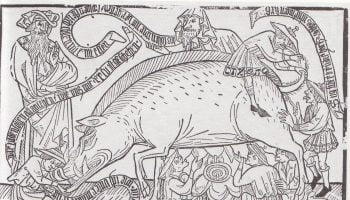Guest post from Ian D. Morris, who is a scholar of Medieval Islamic culture, currently pursuing a Ph.D. with the Spanish National Research Council in Madrid. He blogs on related issues over at http://www.iandavidmorris.com/, and tweets at @iandavidmorris
The self-proclaimed Islamic State – a doctrinaire Sunni insurgency now ruling northern Mesopotamia – is better known in the English-speaking world as ISIS: the Islamic State in Iraq and Syria. But another name, with rather different connotations, has started to gain traction: ISIL, the Islamic State in Iraq and the Levant. Both ISIS and ISIL are meant to translate the group’s slightly outdated Arabic title, al-Dawla al-Islamiyya fi’l-Iraq wa’l-Sham.
It all hinges on how we understand that last word, ‘Sham’: ‘Syria’ or ‘Levant’? It’s a trickier issue than you might think.
Barack Obama prefers ISIL, leading conservative commentators to speculate that he’s trying to emphasise the group’s attachment to Iraq (Mr. Bush’s problem) and downplay its role in Syria. The Independent offers a less paranoid explanation: ISIL makes better sense than ISIS because its “stated goal is to restore an Islamic state, or caliphate, in this entire area”, the Levant.
To a medievalist, this makes sense. ‘Sham’ is a consciously old-fashioned word, not unlike ‘Levant’ itself. (It’s rather like using ‘Persia’ instead of ‘Iran’.) Medieval Sham was understood to comprise a long strip of land from the Taurus Mountains down to the Gulf of Aqaba, confined by the Mediterranean to the west, the desert to the south and east, and the Euphrates to the north-east. It therefore contained all of Palestine, Transjordan and Lebanon as well as most of modern-day Syria; although the rest of Syria, on the other side of the Euphrates – where ISIS now resides – was then considered part of ‘al-Jazira’ or northern Mesopotamia.
Perhaps it is simply the case that ISIS has its greedy eye on the rest of the Levant. But it’s striking how often the choice of ‘Sham’ over ‘Syria’ marks a group out as ideologically Islamist. Secular revolutionaries include the Syrian National Coalition and the Free Syrian Army; among Islamists there’s not only the Islamic State in Iraq and Sham, but also the Front to Support the People of Sham, the Free People of Sham, and even more. There’s something about ‘Sham’ that feels Islamic in a way that ‘Syria’ doesn’t. To find out why, we have to go back in time to the early Middle Ages.
Orientation in the Orient
Throughout history the rising sun was a daily reference point for travellers. Facing east – toward the orient that orientates us – the south is on our right and the north is on our left. Many languages preserve this original association between north-south and left-right; Arabic is one of them. Residents of the dry, impoverished heartland of the Arabian Peninsula, facing east, found that the tropical southern corner of the Peninsula was on their right, yaman, so they called it Yemen. The civilised north – always a province of some great empire – was on their left, sha’m, so they called it Sham.

Clearly ‘Sham’ made sense only from an Arabian perspective. The natives of the region preferred ‘Syria’, a name with a grand imperial history. It probably goes back to the Assyrian empire – from Ashur in Iraq – that had dominated the Levant from the ninth to the seventh centuries BCE, leaving a hefty cultural and linguistic heritage. In the late fourth century BCE, Alexander of Macedon conquered the Middle East, and one of the dynasties that inherited his lands, the Seleucids, became known as “the kings of Syria”. After the Romans captured Syria in the first century BCE, they continued to use that name for at least one province in the region.
When the Arabs conquered the Middle East in the seventh century CE, they brought the name ‘Sham’ with them. The ‘rightly guided’ caliph Umar didn’t call it Syria when his armies conquered it; the Umayyad dynasty, who ruled everything between Spain and Sindh from their Levantine palaces, certainly didn’t call it Syria. Over the centuries, as more and more of the population was Arabised and Islamicised, ‘Sham’ became standard and the adjective ‘Syrian’ was slowly restricted to those Christian communities who spoke some dialect of Aramaic. Even today many of these communities call themselves Syrians (Suryaye) or Assyrians (Athuraye).
Europeans, meanwhile, went on using ‘Syria’ to refer to the Levant. In the nineteenth century, the great expansion of European power and interest in the Middle East meant that the (by now) foreign name ‘Syria’ was reintroduced in official and intellectual circles. Arab thinkers – especially those from religious minorities – absorbed the nationalist ideas coming out of Europe and promoted the idea of a secular Syrian state, independent from the Ottoman Empire.
When the state of Syria itself finally emerged – the Syrian Arab Republic – it was a product of European meddling, forged under the mandate system and granted independence only when Europe was too exhausted by the Second World War to keep a hold on it. Islamists consider its leaders, including Bashar al-Assad, to be American stooges. Their secularism is an affront, and their personal ecumenism is scorned: Assad himself is a member of the Alawi denomination of Twelver Shi‘i Islam, whereas ISIS and its friends are Sunni Salafis.
Looking back on so many years of Levantine history, it can hardly be a surprise that Islamists view ‘Syria’ as a foreign, connotatively Christian name for an illegitimate, un-Islamic puppet state. (Iraq doesn’t have this problem: the name is classically Arab-Islamic.) An Islamist organisation could never claim to operate in ‘Syria’ because no such place is meant to exist; it could only operate in ‘Sham’, which the founding fathers of Islam – Salaf; hence ‘Salafi’ – once ruled in righteousness. Or so we’re told.
Perhaps ‘Levant’ is an unfortunate translation, having such old colonial connotations. But what else is there? ‘Syria’ doesn’t capture the Islamist conception of ‘Sham’: romantic, medieval, Arabist, postnationalist. I don’t have an answer to this – and now that ISIS has claimed caliphal legitimacy over the whole planet as ‘The Islamic State’, it may no longer matter – but there’s a certain irony to the name Sham that’s worth preserving. In many languages, the left hand is linked with misfortune: think of Latin sinister and French gauche. Likewise, the root of Sham, sh-’-m, has connotations of an ominous portent and a dreadful calamity. There’s something rather apt about the thought that, the closer Syria becomes to Sham, the closer it gets to catastrophe.





Comments are closed.